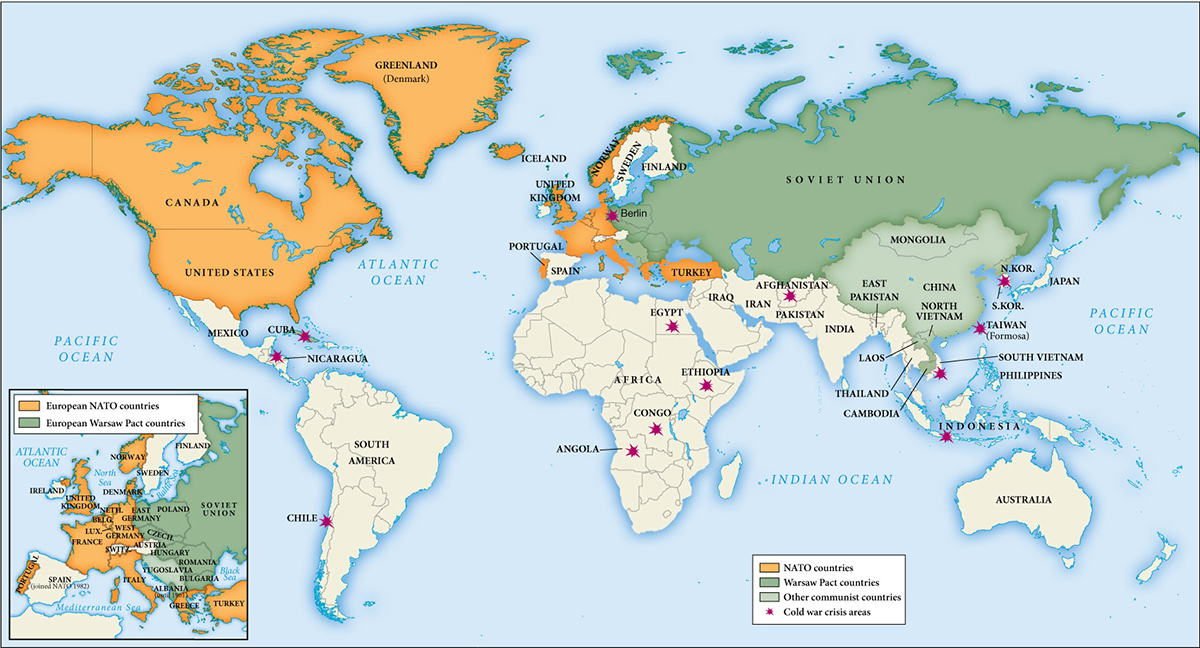Ways of the World with Sources
Printed Page 948
Ways of the World
Printed Page 794
Chapter Timeline
Military Conflict and the Cold War
The initial arena of the cold war was Eastern Europe, where Soviet insistence on security and control clashed with American and British desires for open and democratic societies with ties to the capitalist world economy. What resulted were rival military alliances (NATO and the Warsaw Pact), a largely voluntary American sphere of influence in Western Europe, and an imposed Soviet sphere in Eastern Europe. The heavily fortified border between Eastern and Western Europe came to be known as the Iron Curtain. Thus Europe was bitterly divided. But although tensions flared across this dividing line, particularly in Berlin, no shooting war occurred between the two sides (see Map 21.3).

Map 21.3 The Global Cold War The cold war witnessed a sharp division between the communist world and the Western democratic world. It also divided the continent of Europe; the countries of China, Korea, Vietnam, and Germany; and the city of Berlin. In many places, it also sparked crises that brought the nuclear-armed superpowers of the United States and the USSR to the brink of war, although in every case they managed to avoid direct military conflict between themselves. Many countries in Africa and Asia claimed membership in a Non-Aligned Movement, which sought to avoid entanglements in cold war conflicts.
In what different ways was the cold war expressed?
By contrast, the extension of communism into Asia—China, Korea, and Vietnam—globalized the cold war and occasioned its most destructive and prolonged “hot wars.” A North Korean invasion of South Korea in 1950 led to both Chinese and American involvement in a bitter three-year war (1950–1953), which ended in an essential standoff that left the Korean peninsula still divided in the early twenty-first century. Likewise in Vietnam, military efforts by South Vietnamese communists and the already-communist North Vietnamese government to unify their country prompted massive American intervention in the 1960s. To American authorities, a communist victory opened the door to further communist expansion in Asia and beyond. Armed and supported by the Soviets and Chinese and willing to endure enormous losses, the Vietnamese communists bested the Americans, who were hobbled by growing protest at home. The Vietnamese united their country under communist control by 1975.
A third major military conflict of the cold war era occurred in Afghanistan, where a Marxist party had taken power in 1978. Soviet leaders were delighted at this extension of communism on their southern border, but radical land reforms and efforts to liberate Afghan women soon alienated much of this conservative Muslim country and led to a mounting opposition movement. Fearing the overthrow of a new communist state and its replacement by Islamic radicals, Soviet forces intervened militarily and were soon bogged down in a war they could not win. For a full decade (1979–1989), that war was a “bleeding wound,” sustained in part by U.S. aid to Afghan guerrillas. Under widespread international pressure, Soviet forces finally withdrew in 1989, and the Afghan communist regime soon collapsed. In Vietnam and Afghanistan, both superpowers painfully experienced the limits of their power.
The most haunting battle of the cold war era was one that never happened. The setting was Cuba, where a communist regime under the leadership of Fidel Castro had emerged by the early 1960s. (See Zooming In: The Cuban Revolution.) Intense American hostility to this nearby outpost of communism prompted the Soviet leader Nikita Khrushchev (KROOSH-chef), who had risen to power after Stalin’s death in 1953, to secretly deploy nuclear-tipped Soviet missiles to Cuba, believing that this would deter further U.S. action against Castro. When the missiles were discovered in October 1962, the world held its breath for thirteen days as American forces blockaded the island and prepared for an invasion. A nuclear exchange between the superpowers seemed imminent, but that catastrophe was averted by a compromise between Khrushchev and U.S. president John F. Kennedy. Under its terms, the Soviets removed their missiles from Cuba in return for an American promise not to invade the island. That promise was kept and a communist regime still persists in Cuba, though much changed, well into the twenty-first century.
